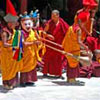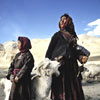
the 10th century, a direct descendent of Lang Darma, Lha Chen Palgyi-Gon, conquered Ladakh and began the rule known as the Lha Chen Dynasty. Although little is known of this dynasty’s kings, who held power from the 10th to 15th centuries, crucial aspects of Ladakh’s cultural and religious practices were initiated during this period. Under the Lha Chen dynasty, Ladakh’s first texts on Tibetan Buddhism were produced and Buddhism became the state religion – protected and propagated by the monarchy. In order to better understand and implement Buddhism, Ladakh turned toward Tibet and sent its novice monks to Tibetan monasteries for their studies. It was this practice that resulted in the Tibetanisation of Ladakhi Buddhism. However, Ladakh has never consolidated both religious and secular powers in one ruler, as Tibet did when it began the rule of the Dalai Lamas in the 16th century. Tsong-Kha-pa, a famous commentator on Tibetan Buddhism (1357-1419) became the founder of the Gelug pa, or yellow-hat sect in the 14th century. His followers who came to Ladakh at the end of the 15th century, established Spitok, the first Gelug pa gompa in Ladakh. Other gompas already established in Ladakh gradually began to follow this new religious order.
In 1533 new rulers, who became the Namgyal Dynasty, conquered Ladakh. This line originated with Chovang Namgyal, a descendant of the Tibetan royal family. The most important of his successors was Singe Namgyal who ruled during a period of relative peacefulness in the 17th century. He engaged in the extensive building and renovation of Ladakh’s gompas, building Hemis Gompa on behalf of his Tibetan monk protégé, Stagtshang Raspa, and later in his reign, founded Stokna and Chemre gompas. Leh Palace, now undergoing restoration work, was also constructed by Singe Namgyal. The ubiquitous mani walls were also introduced to the area during this great king’s reign.
At his death, Singe Namgyal’s kingdom was divided and the area currently known as Ladakh eventually passed to his grandson Deldan Namgyal (ca. 1675-1705). This ruler erected the golden Buddha at Shey, the largest Buddha statue in Ladakh until Thiksey gompa installed a larger one in the 1970s, and still the largest metal statue in Ladakh. Deldan Namgyal became involved in various alternating wars and alliances with both the Tibetan government and the Moslem kings of Kashmir (Kashmir having previously converted from Buddhism to Islam). In return for Kashmiri assistance against Tibet Deldan Namgyal promised, among other things, to build a mosque in Leh. The king kept his promise and the mosque, at the end of Leh’s main street, is still in use. Later, after the Mughals had left Ladakh, Tibet invaded the area and imposed other conditions, including that of an annual tribute being sent to Tibet. During the 18th and early 19th centuries, Ladakh engaged in internal consolidation under a series of weak kings. Tibetan influence produced some innovations: primogeniture was introduced to determine succession to the Ladakhi throne, and younger brothers of the king were sent to monasteries.
In the early 18th century, the king began appointing village elders to assist in ruling. This practice was probably the basis of the village headman tradition that is still current. Printing presses to produce religious texts were also introduced at this time. All religious texts are still written in Tibetan: further testimony to Tibetan influence in Ladakh.
In the 18th century Sikh rule was established over Jammu and Kashmir. A general in the Jammu army, Zorawar Singh, invaded Ladakh in what became known as the Dogra Invasion of 1834. Leh Palace was heavily damaged and the King of Ladakh retreated to Stok, where the family still lives (the most recent king was crowned in 1992).
With the coming of the British Raj, Ladakh was placed in the newly created State of Jammu and Kashmir under the supervision of the Maharajah of Kashmir. The Ladakhi king thus became a vassal of this Maharajah. The most recent king was crowned in 1992.






